
Polypores are a group of fungi that form large fruiting bodies with pores or tubes on the underside. They are a morphological group of basidiomycetes-like gilled mushrooms and hydnoid fungi, and not all polypores are closely related to each other. Polypores are also called bracket fungi or shelf fungi, and they characteristically produce woody, shelf- or bracket-shaped or occasionally circular fruiting bodies that are called conks.

Laetiporus sulphureus is a species of bracket fungus found in Europe and North America. Its common names are crab-of-the-woods, sulphur polypore, sulphur shelf, and chicken-of-the-woods. Its fruit bodies grow as striking golden-yellow shelf-like structures on tree trunks and branches. Old fruitbodies fade to pale beige or pale grey. The undersurface of the fruit body is made up of tubelike pores rather than gills.

Trametes versicolor – also known as Coriolus versicolor and Polyporus versicolor – is a common polypore mushroom found throughout the world. Meaning 'of several colors', versicolor accurately describes this fungus that displays a unique blend of markings. Additionally, owing to its shape being similar to that of a wild turkey's tail feathers, T. versicolor is most commonly referred to as turkey tail. A similar-looking mushroom commonly called "false turkey tail" is from a different order (Stereum), and thus may sometimes be confused with the 'true' turkey tail mushroom, T. versicolor. Another lookalike is the multicolor gill polypore, T. betulina.
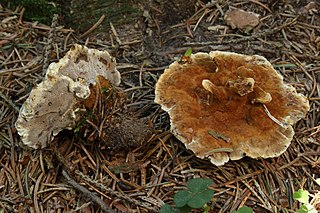
Onnia tomentosa is a species of fungus in the family Hymenochaetaceae commonly known as the woolly velvet polypore. It is frequently found in coniferous forests at higher altitudes, often growing in large groups, rather rare at lower altitudes. It is a plant pathogen, and causes tomentosus root rot, primarily in spruce. It was formerly known as Inonotus tomentosum (Fr.) Teng until molecular phylogenetic analysis led to major revisions in the classification of the Hymenochaetaceae.

Phellinus noxius is a plant pathogen. It attacks a wide range of tropical plants, and is the cause of brown root rot disease. It was described as "an aggressive and destructive pathogen". The pathogen invades roots with contact between roots of a potential host with the substrate on which the fungus is growing.
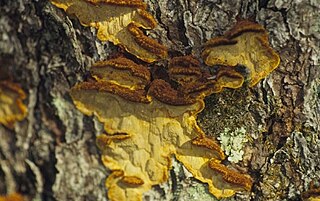
Phellinus pini is a fungal plant pathogen that causes tree disease commonly known as "red ring rot" or "white speck". This disease, extremely common in the conifers of North America, decays tree trunks, rendering them useless for lumber. It is a rot of the heartwood. Signs of the fungus include shelf-shaped conks protruding from the trunks of trees. Spores produced on these conks are blown by the wind and go on to infect other trees. Formal management of this disease is limited, and the disease is controlled primarily by cultural practices. Red ring rot is an important forest disturbance agent and plays a key role in habitat formation for several forest animals.

Phaeolus schweinitzii, commonly known as velvet-top fungus, dyer's polypore, dyer's mazegill, or pine dye polypore, is a fungal plant pathogen that causes butt rot on conifers such as Douglas-fir, spruce, fir, hemlock, pine, and larch. P. schweinitzii is a polypore, although unlike bracket fungi the fruiting body may appear terrestrial when growing from the roots or base of the host tree.

Meripilus giganteus is a polypore fungus in the family Meripilaceae. It causes a white rot in various types of broadleaved trees, particularly beech (Fagus), but also Abies, Picea, Pinus, Quercus and Ulmus species. This bracket fungus, commonly known as the giant polypore or black-staining polypore, is often found in large clumps at the base of trees, although fruiting bodies are sometimes found some distance away from the trunk, parasitizing the roots. M. giganteus has a circumboreal distribution in the northern Hemisphere, and is widely distributed in Europe. In the field, it is recognizable by the large, multi-capped fruiting body, as well as its pore surface that quickly darkens black when bruised or injured.

Phellinus igniarius is a fungus of the family Hymenochaetaceae. Like other members of the genus of Phellinus it lives by saprotrophic nutrition, in which the lignin and cellulose of a host tree is degraded and is a cause of white rot. Common names are willow bracket and fire sponge.

Phellinus is a genus of fungi in the family Hymenochaetaceae. Many species cause white rot. Fruit bodies, which are found growing on wood, are resupinate, sessile, and perennial. The flesh is tough and woody or cork-like, and brown in color. Clamp connections are absent, and the skeletal hyphae are yellowish-brown.

Bridgeoporus is a fungal genus in the family Polyporaceae. A monotypic genus, it contains the single polypore species Bridgeoporus nobilissimus, first described to science in 1949. Commonly known both as the noble polypore and the fuzzy Sandozi, this fungus produces large fruit bodies that have been found to weigh up to 130 kilograms (290 lb). The upper surface of the fruit body has a fuzzy or fibrous texture that often supports the growth of algae, bryophytes, or vascular plants.
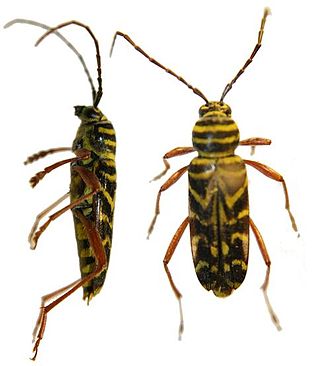
Megacyllene robiniae, commonly known as the locust borer, is a species of longhorn beetle endemic to eastern North America. It is a serious pest of Robinia pseudoacacia, the black locust tree, with which it is sympatric.

Fuscoporia torulosa is a species of bracket fungus in the genus Fuscoporia, family Hymenochaetaceae. A wood-decay fungus, it causes a white rot of heartwood in dead and living hardwood trees in Europe, and in coniferous trees in North America.

Grifola frondosa is a polypore mushroom that grows at the base of trees, particularly old growth oaks or maples. It is typically found in late summer to early autumn. It is native to China, Europe, and North America.

Inonotus dryadeus, commonly known as oak bracket, warted oak polypore, weeping polypore or weeping conk, is an inedible species of fungus belonging to the genus Inonotus, which consists of bracket fungi with fibrous flesh. Most often found growing at the base of oak trees, it causes white rot and decay of the trunks. It secretes an amber liquid which weeps from tubes in its upper surface.

Fomes fomentarius is a species of fungal plant pathogen found in Europe, Asia, Africa and North America. The species produces very large polypore fruit bodies which are shaped like a horse's hoof and vary in colour from a silvery grey to almost black, though they are normally brown. It grows on the side of various species of tree, which it infects through broken bark, causing rot. The species typically continues to live on trees long after they have died, changing from a parasite to a decomposer.
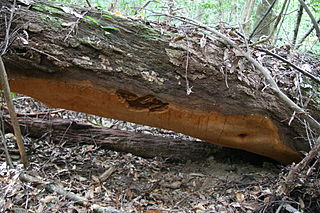
Phellinus ellipsoideus is a species of polypore fungus in the family Hymenochaetaceae, a specimen of which produced the largest fungal fruit body ever recorded. Found in China, the fruit bodies produced by the species are brown, woody basidiocarps that grow on dead wood, where the fungus feeds as a saprotroph. The basidiocarps are perennial, allowing them to grow very large under favourable circumstances. They are resupinate, measuring 30 centimetres (12 in) or more in length, though typically extending less than a centimetre from the surface of the wood. P. ellipsoideus produces distinct ellipsoidal spores, after which it is named, and unusual setae. These two features allow it to be readily differentiated microscopically from other, similar species. Chemical compounds isolated from the species include several steroidal compounds. These may have pharmacological applications, but further research is needed.

Hapalopilus rutilans is a species of polypore fungus in the family Polyporaceae. Officially described in 1821, it was transferred to its current genus Hapalopilus six decades later. It is commonly known as the tender nesting polypore, purple dye polypore, or the cinnamon bracket. This widely distributed species is found on five continents. It grows on the fallen or standing dead wood of deciduous trees, in which it fruits singly, in groups, fused, or in overlapping clusters. Fruit bodies are in the form of kidney-shaped to semicircular, cinnamon-orange-brown brackets. The underside of the fruit body features a yellowish to brownish pore surface with tiny angular pores, from which spores are released.

Sarcodon rimosus, commonly known as the cracked hydnum, is a species of tooth fungus in the family Bankeraceae. Found in the Pacific Northwest region of North America, it was described as new to science in 1964 by mycologist Kenneth A. Harrison, who initially called it Hydnum rimosum. He transferred it to the genus Sarcodon in 1984. Fruit bodies of S. rimosum have convex to somewhat depressed caps that are 4–12 cm (1.6–4.7 in) in diameter. The surface becomes scaly in age, often developing conspicuous cracks and fissures. It is brown with violet tints. The flesh lacks any significant taste and odor. Underneath the cap cuticle, the flesh turns a bluish-green color when tested with a solution of potassium hydroxide. The brownish-pinks spines on the cap underside are typically 2.5–7 mm long, extending decurrently on the stipe. Spores are roughly spherical with fine warts on the surface, and measure 5–6.5 by 4.5–5 µm. The hyphae do not have clamp connections.
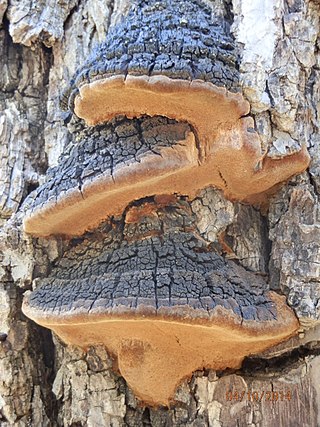
Fulvifomes is a genus of fungi in the family Hymenochaetaceae.




















